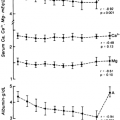WATER HOMEOSTASIS
VOLUME, COMPOSITION, DISTRIBUTION, AND BALANCE
Water is by far the largest constituent of the human body. In lean, healthy adults, it constitutes 55% to 65% of body weight, and in infants and young children, it represents an even larger proportion.57 Approximately two-thirds of body water is intracellular. The rest is extracellular and is divided further into the intravascular (plasma) and extravascular (interstitial) compartments. Plasma is much the smaller of the two, constituting only approximately one-fourth of the total extracellular volume.
The solute composition of intracellular and extracellular fluid differs markedly because most cell membranes possess an array of transport systems that actively accumulate or expel specific solutes.58 However, the total solute concentration of the extracellular and the intracellular fluid is always the same because most cell membranes are freely permeable to water. Thus, distribution of water between the intracellular and extracellular compartments is determined by osmotic pressure resulting from differences in the solute content of the two compartments. If the total solute concentration of one compartment changes, the difference in osmotic pressure induces a rapid efflux or influx of water from the neighboring compartments until osmotic equilibrium is restored.59,60 Similarly, the distribution of extracellular water between the intravascular and interstitial compartments is determined largely by the balance of hemodynamic and oncotic pressure.
The total amount of water in the body is determined by the balance between intake and loss to the environment. The latter occurs via two routes; urination and evaporation, mostly from skin and lungs. The amounts lost via either route can vary markedly depending on antidiuretic function, solute load, physical activity, and temperature. However, even when conservation is maximum, the total amount of water lost by a healthy 70-kg adult cannot be reduced below ˜1000 mL a day. Part of this obligatory loss can be replaced by the metabolism of fat (˜300 mL per day in the average adult). The rest must come from the ingestion of water either as food or beverage. Thus, the mechanisms for ensuring an adequate intake of water are the most important for maintaining normal hydration.
Stay updated, free articles. Join our Telegram channel

Full access? Get Clinical Tree





